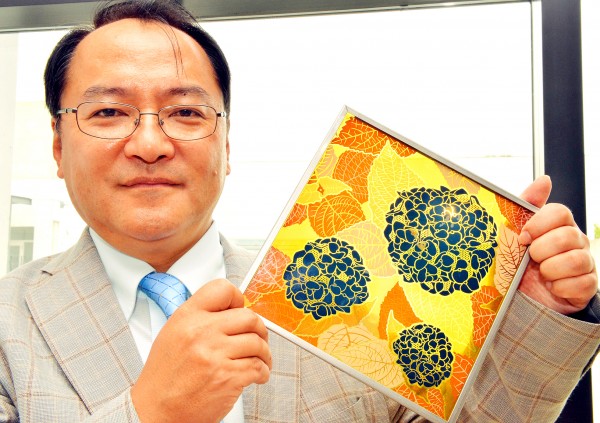《TAIPEI TIMES 焦點》Japanese academic debuts flower-inspired solar cell

Hiroshi Segawa, a professor at the University of Tokyo’s Research Center for Advanced Science and Technology, shows a prototype of an organic solar power cell at his laboratory in Tokyo on July 24. Photo: AFP
ADAPTABLE ENERGY: ‘You can make solar cells out of ... portraits of real people and lots of other stuff,’ Japanese professor Hiroshi Segawa has said
AFP, TOKYO
A solar cell that resembles a flower offers a new take on “green” energy in Japan, where one scientist is searching for renewables that look good.
In a country badly scarred by the earthquake and tsunami-sparked disaster at the Fukushima Dai-ichi nuclear power plant three years ago, the hydrangea-inspired solar offering might seem insignificant alongside one of the world’s biggest offshore wind power farms now off Japan’s east coast, but Hiroshi Segawa, a professor at the University of Tokyo’s Research Center for Advanced Science and Technology, is hoping his dye-sensitized solar cell, which meshes floral beauty with cutting-edge technology, will brighten the scene.
Segawa’s Annabelle, named after a type of white hydrangea, is made up of flowery stained glass-like solar cells built into a latticed wood box modeled on traditional Japanese doors.
While the 20cm-wide box might make a pretty addition to a sunroom, it can also store enough energy to charge your smartphone twice. The leaves generate electricity that is then stored in the flower. As the device charges, the petals turn increasingly blue. However, as Annabelle discharges, those blue petals turn white, just like a real-life hydrangea.
“People do not have a very good image about things related to energy, such as nuclear power,” Segawa told reporters. “Thermal power generation conjures up images of blistering hot dirty coal, while solar panels take up a lot of space. Even wind power generation has problems with bird strikes and noise, but [Annabelle] does not harm the environment.”
While Segawa is not expecting to topple the dominant silicon-based solar panels, he is hoping the fast-growing sector has room for “enjoyable energy” that adds a splash of color to an otherwise drab industry.
Since the disaster in 2011, Japan has been pushing to boost the use of alternative sources of energy.
The country’s solar power generation is rapidly growing, but it still only represents a small share of the overall power mix.
In Japan, the share of power generated from renewable sources, excluding hydropower, lags behind other developed economies at 4.7 percent of the total, far less than 10.4 percent in Britain or the 20.1 percent in Germany, according to data from the International Energy Agency.
Japan’s nuclear plants were shuttered after the 2011 atomic accident — yanking away a power source that once supplied more than one-quarter of the nation’s energy.
Despite Tokyo’s efforts to develop the solar sector, the weather — particularly a lack of reliable sunlight — is among the factors holding back wider use. However, Segawa says Annabelle works even in weak indoor light. It also has a myriad of design possibilities. Segawa has already experimented with a cell that looks like French President Francois Hollande and one resembling the computer-generated Japanese pop star Hatsune Miku.
“You can make solar cells out of animated characters, portraits of real people and lots of other stuff,” he said.
新聞來源:TAIPEI TIMES














